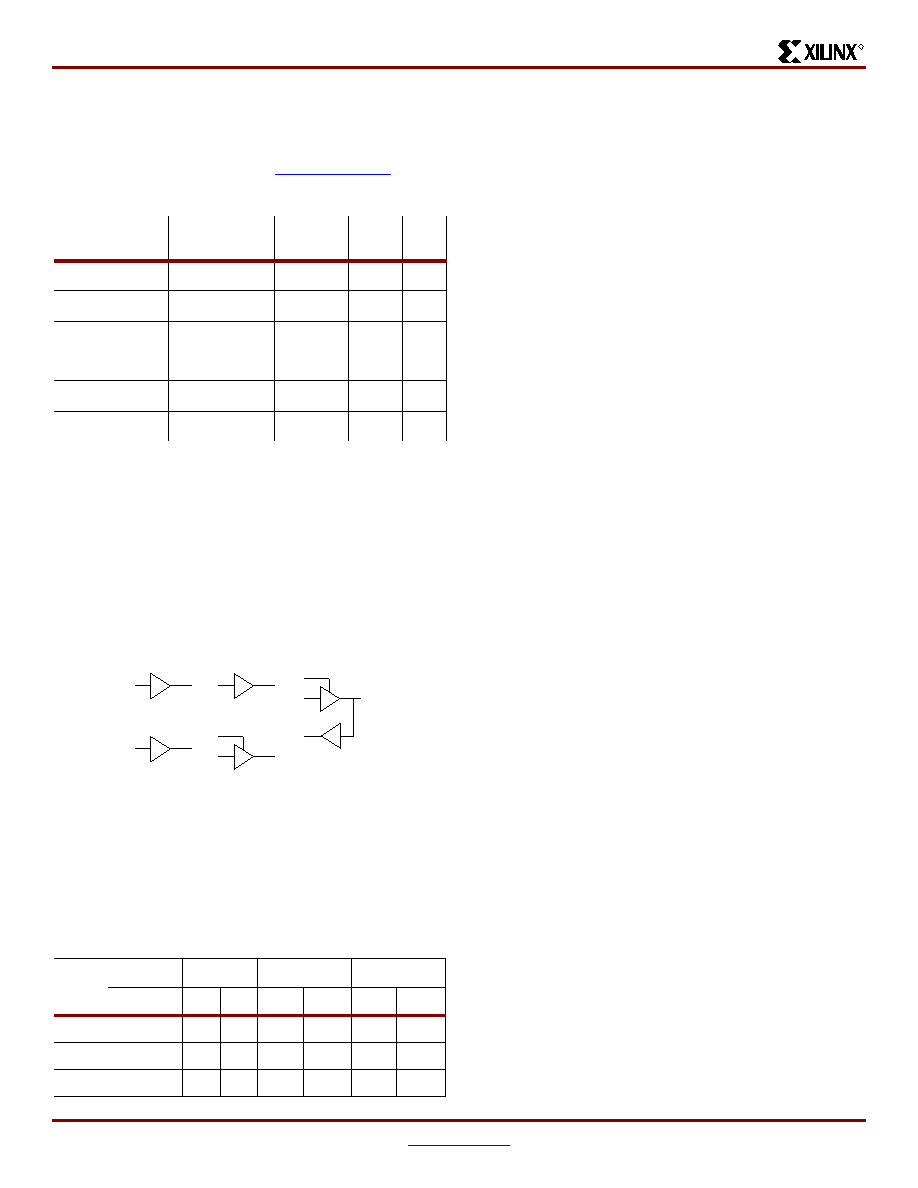- 您現(xiàn)在的位置:買賣IC網(wǎng) > PDF目錄4204 > XCV812E-7FG900C (Xilinx Inc)IC FPGA 1.8V C-TEMP 900-FBGA PDF資料下載
參數(shù)資料
| 型號: | XCV812E-7FG900C |
| 廠商: | Xilinx Inc |
| 文件頁數(shù): | 65/118頁 |
| 文件大小: | 0K |
| 描述: | IC FPGA 1.8V C-TEMP 900-FBGA |
| 產(chǎn)品變化通告: | FPGA Family Discontinuation 18/Apr/2011 |
| 標準包裝: | 1 |
| 系列: | Virtex®-E EM |
| LAB/CLB數(shù): | 4704 |
| 邏輯元件/單元數(shù): | 21168 |
| RAM 位總計: | 1146880 |
| 輸入/輸出數(shù): | 556 |
| 門數(shù): | 254016 |
| 電源電壓: | 1.71 V ~ 1.89 V |
| 安裝類型: | 表面貼裝 |
| 工作溫度: | 0°C ~ 85°C |
| 封裝/外殼: | 900-BBGA |
| 供應商設備封裝: | 900-FBGA |
第1頁第2頁第3頁第4頁第5頁第6頁第7頁第8頁第9頁第10頁第11頁第12頁第13頁第14頁第15頁第16頁第17頁第18頁第19頁第20頁第21頁第22頁第23頁第24頁第25頁第26頁第27頁第28頁第29頁第30頁第31頁第32頁第33頁第34頁第35頁第36頁第37頁第38頁第39頁第40頁第41頁第42頁第43頁第44頁第45頁第46頁第47頁第48頁第49頁第50頁第51頁第52頁第53頁第54頁第55頁第56頁第57頁第58頁第59頁第60頁第61頁第62頁第63頁第64頁當前第65頁第66頁第67頁第68頁第69頁第70頁第71頁第72頁第73頁第74頁第75頁第76頁第77頁第78頁第79頁第80頁第81頁第82頁第83頁第84頁第85頁第86頁第87頁第88頁第89頁第90頁第91頁第92頁第93頁第94頁第95頁第96頁第97頁第98頁第99頁第100頁第101頁第102頁第103頁第104頁第105頁第106頁第107頁第108頁第109頁第110頁第111頁第112頁第113頁第114頁第115頁第116頁第117頁第118頁

Virtex-E 1.8 V Extended Memory Field Programmable Gate Arrays
Module 2 of 4
DS025-2 (v3.0) March 21, 2014
46
R
— OBSOLETE — OBSOLETE — OBSOLETE — OBSOLETE —
Termination Resistor Packs
Resistor packs are available with the values and the config-
uration required for LVDS and LVPECL termination from
Bourns, Inc., as listed in Table. For pricing and availability,
please contact Bourns directly at www.bourns.com.
LVDS Design Guide
The SelectI/O library elements have been expanded for Vir-
tex-E devices to include new LVDS variants. At this time all
of the cells might not be included in the Synthesis libraries.
The 2.1i-Service Pack 2 update for Alliance and Foundation
software includes these cells in the VHDL and Verilog librar-
ies. It is necessary to combine these cells to create the
P-side (positive) and N-side (negative) as described in the
input, output, 3-state and bidirectional sections.
Creating LVDS Global Clock Input Buffers
The global clock input buffer can be combined with the adja-
cent IOB to form an LVDS clock input buffer. The P-side
resides in the GCLKPAD location and the N-side resides in
the adjacent IO_LVDS_DLL site.
HDL Instantiation
Only one global clock input buffer is required to be instanti-
ated in the design and placed on the correct GCLKPAD
location. The N-side of the buffer is reserved and no other
IOB is allowed to be placed on this location.
In the physical device, a configuration option is enabled that
routes the pad wire to the differential input buffer located in
the GCLKIOB. The output of this buffer then drives the out-
put of the GCLKIOB cell. In EPIC it appears that the second
buffer is unused. Any attempt to use this location for another
purpose leads to a DRC error in the software.
VHDL Instantiation
gclk0_p : IBUFG_LVDS port map
(I=>clk_external, O=>clk_internal);
Verilog Instantiation
IBUFG_LVDS gclk0_p (.I(clk_external),
.O(clk_internal));
Location Constraints
All LVDS buffers must be explicitly placed on a device. For
the global clock input buffers this can be done with the fol-
lowing constraint in the UCF or NCF file.
NET clk_external LOC = GCLKPAD3;
GCLKPAD3 can also be replaced with the package pin
name, such as D17 for the BG432 package.
Optional N-Side
Some designers might prefer to also instantiate the N-side
buffer for the global clock buffer. This allows the top-level net
list to include net connections for both PCB layout and sys-
tem-level integration. In this case, only the output P-side
IBUFG connection has a net connected to it. Since the
N-side IBUFG does not have a connection in the EDIF net
list, it is trimmed from the design in MAP.
VHDL Instantiation
gclk0_p : IBUFG_LVDS port map
(I=>clk_p_external, O=>clk_internal);
gclk0_n : IBUFG_LVDS port map
(I=>clk_n_external, O=>clk_internal);
Verilog Instantiation
IBUFG_LVDS gclk0_p (.I(clk_p_external),
.O(clk_internal));
IBUFG_LVDS gclk0_n (.I(clk_n_external),
.O(clk_internal));
Location Constraints
All LVDS buffers must be explicitly placed on a device. For
the global clock input buffers this can be done with the fol-
lowing constraint in the UCF or NCF file.
NET clk_p_external LOC = GCLKPAD3;
NET clk_n_external LOC = C17;
Table 40:
Bourns LVDS/LVPECL Resistor Packs
Part Number
I/O Standard
Term.
for:
Pairs/
Pack
Pins
CAT16
LV2F6
LVDS
Driver
2
8
CAT16
LV4F12
LVDS
Driver
4
16
CAT16
PC2F6
LVPECL
Driver
2
8
CAT16
PC4F12
LVPECL
Driver
4
16
CAT16
PT2F2
LVDS/LVPECL
Receiver
2
8
CAT16
PT4F4
LVDS/LVPECL
Receiver
4
16
Figure 58: LVDS Elements
Table 41:
Global Clock Input Buffer Pair Locations
Pkg
Pair 3
Pair 2
Pair 0
PN
P
N
P
N
P
N
BG560
A17
C18
D17
E17
AJ17
AM18
AL17
AM17
FG676
E13
B13
C13
F14
AB13
AF13
AA14
AC14
FG900
C15
A15
E15
E16
AK16
AH16
AJ16
AF16
O
I
IBUF_LVDS
O
I
OBUF_LVDS
IOBUF_LVDS
O
T
I
OBUFT_LVDS
O
I
IBUFG_LVDS
IO
T
I
x133_22_122299
相關PDF資料 |
PDF描述 |
|---|---|
| XC6VLX240T-1FFG1759I | IC FPGA VIRTEX 6 241K 1759FFGBGA |
| XC6VLX240T-1FF1759I | IC FPGA VIRTEX 6 241K 1759FFBGA |
| XC5VLX110T-1FFG1136I | IC FPGA VIRTEX-5 110K 1136FBGA |
| XC5VLX110T-1FF1136I | IC FPGA VIRTEX-5 110K 1136FBGA |
| XC6VHX255T-1FFG1155C | IC FPGA VIRTEX 1156FCBGA |
相關代理商/技術(shù)參數(shù) |
參數(shù)描述 |
|---|---|
| XCV812E-7FG900I | 制造商:XILINX 制造商全稱:XILINX 功能描述:Virtex-E 1.8 V Extended Memory Field Programmable Gate Arrays |
| XCV812E-8BG404C | 制造商:XILINX 制造商全稱:XILINX 功能描述:Virtex-E 1.8 V Extended Memory Field Programmable Gate Arrays |
| XCV812E-8BG404I | 制造商:XILINX 制造商全稱:XILINX 功能描述:Virtex-E 1.8 V Extended Memory Field Programmable Gate Arrays |
| XCV812E-8BG556C | 制造商:XILINX 制造商全稱:XILINX 功能描述:Virtex-E 1.8 V Extended Memory Field Programmable Gate Arrays |
| XCV812E-8BG556I | 制造商:XILINX 制造商全稱:XILINX 功能描述:Virtex-E 1.8 V Extended Memory Field Programmable Gate Arrays |
發(fā)布緊急采購,3分鐘左右您將得到回復。